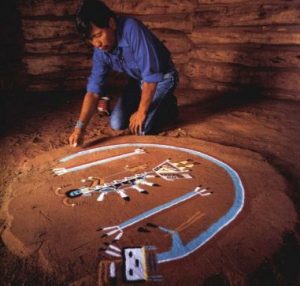Commercialization of the Navajo Sand Painting Practice
Sandpainting Paper
For the Navajo, much like other native american cultures, ritual plays an essential role in building community and establishing culture. The practice of sandpainting is over one hundred years old and remains a staple of the culture. The entire process can take anywhere from one day to over a week, depending on the need and difficulty of the process or painting. Some of the steps include identifying an evil within a community member, prepping for the ceremony, and various ceremonial procedures, concluded with the destroying of most of the sand used in painting. Sandpaintings ritualistic nature is vital to comprehending the values and lifestyle of the Navajo, while simultaneously promoting a community-centered nation.

Order custom essay Commercialization of the Navajo Sand Painting Practice with free plagiarism report
 450+ experts on 30 subjects
450+ experts on 30 subjects
 Starting from 3 hours delivery
Starting from 3 hours delivery
While many argue sandpainting as merely a cultural artistic expression, it’s significance and influence on the rest of Navajo culture proves that it holds a greater ritualistic influence. First, before the ceremony even begins, the identification of evils must take place. This requires going to an employed spiritual person and asking them what they think the root of the evil is, then maybe even going to another person and asking them if they can perform the ceremony for this specific type of evil with their specialized religious skills. If they agree, then the family or person must provide a space for the ceremony to take place (typically their own home), and provide abundant food and water for whoever is in attendance, especially if the ceremony is predicted to last a long time.
Finally, the patient and group members who choose to do so may fast for a designated period of time beforehand and also may practice abstinence. Because the process is so involved, multiple members of the community are directly affected by the ceremony before it even begins. The people performing the ceremony and the people who recommend the painters are, additionally, employed and make their living off of the ceremonies, therefore tying the sandpainting directly back into the community. Such an impact points more strongly to a ritual or religious experience rather than just an artistic pastime.
Second, sandpainting is used to mark transitions from one phase of life to another. In one instance, girls who get their periods for the first time are required to go through a sandpainting ritual. Lincoln writes, “Puberty is the precondition for the performance of the initiation rite… that is believed to bestow the power of bearing children (17)”. Although one cannot actually validate the therapeutic powers of the sandpainting, it’s usage as a practical and essential part of growing old adds significance to it, and points to its ritualistic nature. Other moments (not related to the phases of life) also call for a sandpainting ceremony, and one can always be called upon if a person is in distress or if another Navajo thinks that someone needs spiritual cleansing.
Finally, after the ceremony is finished the members of the community treat the patient as though they are holy, because in theory pieces of the spirit that has been invited into the ceremony remain within that patient for several days. In “Theory of Curing” Richard says, “The purpose of sandpaintings is to allow the patient to absorb the powers depicted”. People go out of their way to make sure they don’t eat the same food as this person, drink from the same cup, or even touch that person. The combined impact of all of these factors and the conscientious changes to their daily lives should point to that the sandpainting ceremony is a ritual in a religious sense, and holds much more significance than just a cultural expression of art.
It is evident now that this ritual, other than being a very involved process, is also deeply connected with the Navajo community. Possibly the most important role that the community plays is that usually one community member recommends another community member as a patient for the ceremony. The criteria for this is that one person may recognize an evil within someone and for the good of the patient but also the community want to exorcise that evil. After it has been established that the ritual is happening, depending on the tribe or nation, Navajo communities may wish for everyone to participate.
Some of the more extreme things, such as drinking emetic in order to vomit and therefore cleanse their inner body, usually remain optional. However some communities may require this, or may require people to participate in the less extreme aspects of the ceremony. Reichard writes, “Some of the visitors at the ceremony sweat and take emetic with him; practically all the attendants shampoo their hair” (110). The importance of sandpainting as a community event eventually strengthens the community, and also the focus on the wellbeing of the patient adds a positive energy to the nation for the time before, during, and after the ceremony.
Sandpainting is engrained in the culture of the Navajo, and its ritualistic nature allows the community to come together and celebrate their culture as well as expel evil within the community and the individual. There is controversy over whether the sandpaintings should be sold, photographed, or recreated. According to the fact that they are ritualistic in nature, this would be greatly offensive to the Navajo tradition. However, until mainstream America can accept all native cultures as legitimate, the fight to preserve Navajo and other native religious traditions continues.
Cite this Page
Commercialization of the Navajo Sand Painting Practice. (2017, May 23). Retrieved from https://phdessay.com/commercialization-of-the-navajo-sand-painting-practice/
Run a free check or have your essay done for you


